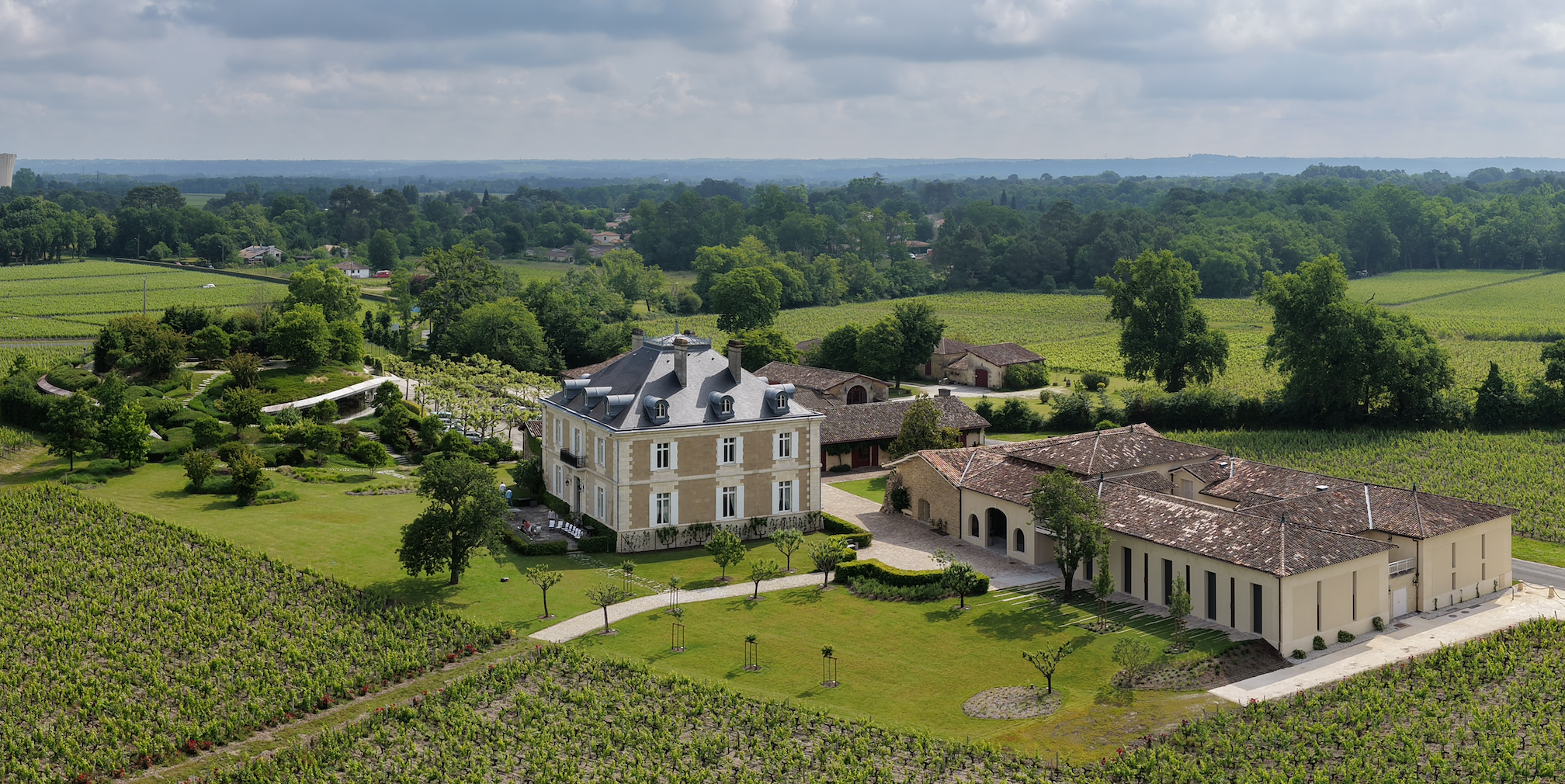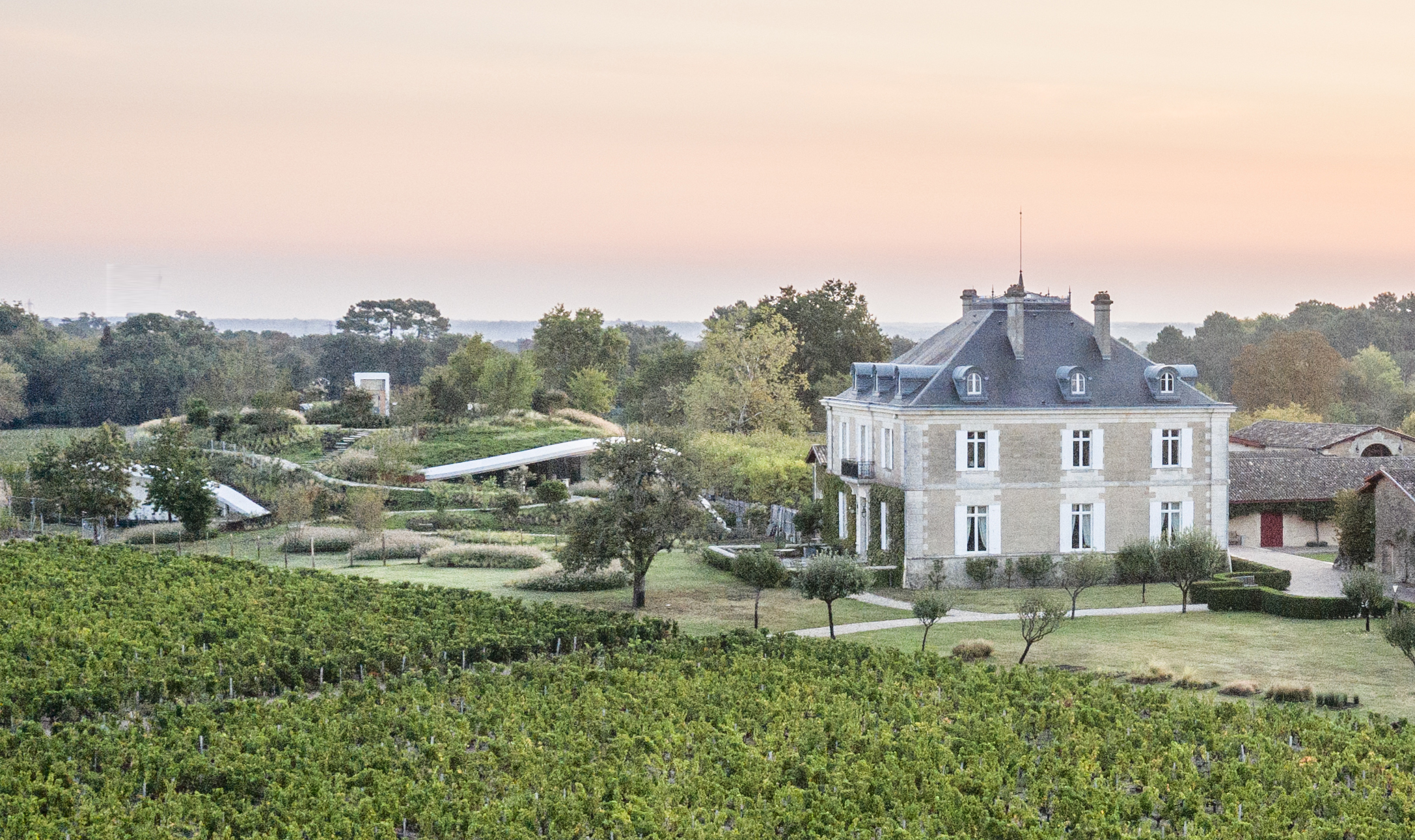As readers of this site know, I worked as a stagiaire on Château Haut-Bailly in 2006 during a sabbatical. Invited by a generous gesture of the estate President, Veronique Sanders and passionately trained by technical director Gabrial Vialard, it became a pivotal moment in my wine journey, reinforcing my passion for Bordeaux and all vinous matters more broadly. I have been back since then, but not after the extensive renovation and extension of the cellar. So, on this Bordeaux trip I made sure that I was able to stop by and see for myself.

The entrance to Haut-Bailly and the new winery, in the middle estate President Veronique Sanders
Château Haut-Bailly
Now Château Haut-Bailly is an estate in Pessac-Léognan that is revered by sophisticated Bordeaux drinkers. Stylistically admired for its restraint, precision, and elegance, avoiding excessive oak or extraction. The wines – often not showy in their youth – reach high level of complexity once mature with notes of cassis, graphite, and tobacco leaf, underpinned by fine tannins and a polished, almost Burgundian texture – especially notable given its Graves origins. Even in warm vintages, Haut-Bailly maintains a sense of freshness and poise that appeals to classicists.
The estate’s legacy dates back to the 16th century with the most recent chapter beginning in 1998 when American financier Robert Wilmers acquired the estate and invested in its vineyards and infrastructure. I met Robert when I worked at the Château. Polite, soft spoken, he was not your typical American who would tell everyone how to do things. Instead he led the existing team to evolve the Château by evolution instead of revolution. I want to particularly mention that Haut-Bailly never adopted the heavy, extracted style that was popular during the peak of the Parker years 2000-2010, instead stuck to their knitting of an elegant expression of Bordeaux. Patiently long-term estate manager Veronique Sanders promoted the estate, showed its quality and progress and this raised its reputation and popularity. The scores followed, even a 100 points from Robert Parker himself.
The estate is located just southeast of the city of Bordeaux on a gravelly rise with deep, sandy-gravel soils over limestone. The 30-hectare vineyard is planted primarily with Cabernet Sauvignon, Merlot, Petit Verdot, and Cabernet Franc, with vines averaging 35 years of age (and some over a century old). This unique combination of old vines and well-drained soils contributes to the estate’s signature balance of depth and finesse.

The new winery, integrated into the landscape
New Winery Project
Château Haut-Bailly’s new winery, inaugurated in 2020, is actually quite different than most Bordeaux renovation projects I have seen. It is not about who has the bigger, more lavish building designed by a famous architect. Quite the opposite. The new Chais is almost invisible because is is integrated into the landscape, half of it underground and the part that is above the ground is covered by an extensive roof garden. It exemplifies a harmonious blend of architectural innovation and environmental stewardship. The vegetated roof serves as a habitat for various species, including birds, butterflies, and bats, contributing to the estate’s ecological diversity. They even collect the rain water in tanks to irrigate the roof garden in the hot summer months. I learned that one of the sons of Robert Wilmers is actually an environmental scientists and one can see his signature here.
The new cuverie (vat room)
The winery has achieved the ‘High Environmental Quality’ (HQE) certification with an ‘Excellent’ rating, reflecting its commitment to sustainability. Energy efficiency is a cornerstone of the design as well with the underground construction providing natural insulation, reducing the need for artificial climate control. As mentioned, rainwater harvesting systems collect and reuse water for cleaning and irrigation, minimizing resource consumption. Additionally, the facility utilizes air heat pumps to regulate temperatures, further lowering its carbon footprint. Inside, the winery has 54 fermentation vats arranged in concentric circles, allowing for plot-by-plot vinification. The design not only enhances the quality of the wine but also improves workflow efficiency and ergonomics for the cellar team. The gravity-fed system reduces the need for mechanical pumping, preserving the integrity of the grapes and conserving energy.

The new chais (barrel cellar)
Oenotourism – visiting the estate
Given this interesting cellar design and the fact that Haut Bailly als has an oenotourism program with visits and guest rooms both at the estate and at the “Chartreuse” (see link) it is really a place not to miss during your Bordeaux stay. The proximity to Bordeaux City of the Pessac-Leognan estate vs the longer ride to Medoc and Libourne, makes it a good place to stay near the vineyards without being too far out.
Oenotourism with guest rooms in the middle of the vineyard
Tasting Notes
Tasted at the estate
2022 Château Haut-Bailly II Pessac-Léognan, 92 Points
This second wine is composed of 65% Merlot, 30% Cabernet Sauvignon, 3% Cabernet Franc, and 2% Malbec. The palate is structured, with a long, precise finish marked by earthy notes and fresh cassis. It shows a racy, fresh character with classic Bordeaux proportions that feel light and elegant. This wine would benefit from an additional 3 to 4 years in the cellar to develop tertiary complexity. Overall, a very attractive and promising second wine.
2022 Château Haut-Bailly Pessac-Léognan, 96-97 Points
The blend here features 56% Cabernet Sauvignon, 37% Merlot, 5% Petit Verdot, and 2% Cabernet Franc, giving it a more Cabernet-driven style. The palate is firm and grippy, precise and well-judged, with notes of cassis, cedar, and subtle smoke. Aromas of dark fruit and forest floor add complexity, while the freshness and sapidity belie the wine’s 14.5% alcohol. This is a very balanced and structured Haut Bailly that will need at least a decade in the cellar to fully reveal its potential.
2015 Château Haut-Bailly Pessac-Léognan, 95 Points
Made from 60% Cabernet Sauvignon, 36% Merlot, and 4% Petit Verdot, this 2015 offers aromas of violets, cassis, and cedar. It is surprisingly approachable at this stage, with a soft, polished palate that is somewhat lighter than expected from Haut Bailly. The wine retains excellent freshness despite the warmth of the vintage, combining charme and seriousness with traditional proportions. A refined and elegant example that is starting to drink well now with a decant and will age gracefully.
Other vintages recently tasted
2016 Chateau Haut Bailly, 98 Points
Like all 2016 this is a wine of classic proportions. What makes this vintage so interesting is the well measured proportions. There is so much depth in the aromatics combined with a laser focused palate. Stylistically similar to 2010, but lighter, while the 2015 is more similar to the 2009. Dont touch this before 2035.
2010 Chateau Haut Bailly, 98 points
Tasted at the Chateau. Having tasted all Haut-Bailly from 1995-2010 (most of them when I worked there during a sabbatical in 2006), this is most likely the best wine they made in recent history, the technical director also feels so. Ultra classic and dense with lots of dark fruit and freshness. Lots of blue and black fruit, smoke and foresty notes. The big surprise though is the softness of tannins, as big and present as they are. Having had the spectacular 1961, I think this wine will go a long, long way and my note still has upside potential. Wow!

The new tasting room with a view onto the the roof garden and commercial director Diana Paulin leading through the tasting
Appellation: Pessac-Léognan
Location: Léognan, south of Bordeaux
Ownership: Wilmers family (since 1998)
Estate Manager / President: Véronique Sanders
Technical director: Gabriel Vialard (since 2021)
Vineyard Size: 30 hectares
Soil Type: Sandy gravel over limestone and clay
Average Vine Age: 35 years (with some over 100 years)
Grape Variety Breakdown: ~60% Cabernet Sauvignon, ~34% Merlot, ~3% Cabernet Franc, ~3% Petit Verdot
Second Wine: Haut-Bailly II (formerly La Parde de Haut-Bailly)
Style: Elegant, structured, age-worthy; fine tannins, freshness, complexity.
If you like this wine, stylistically you will also like Lynch Bages, Grand-Puy Lacoste, Leoville Las Cases, Montrose, Figeac, Ausone
Critical Praise (WA): 2009: 100 pts, 2010: 98 pts, 2016: 98 pts, 2015: 97 pts, 2022: 97 pts
Recent Investments: New gravity-fed winery completed in 2021

Author: Christian Raubach, WSET III, FWS, WSG Champagne Master
May 2025



